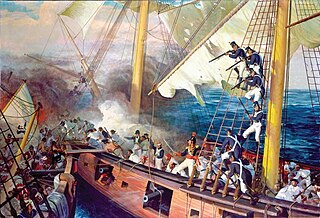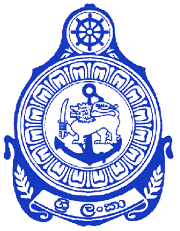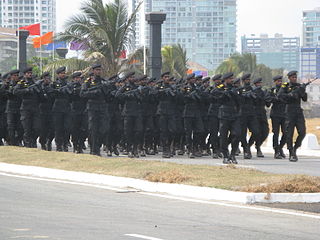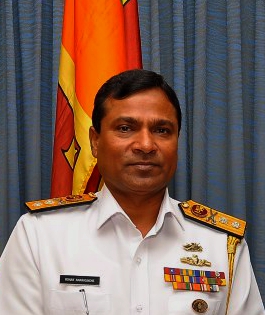
Marines are military personnel who primarily operate in littoral zones, both on land and at sea. Historically, the main tasks undertaken by marines have included raiding ashore in support of naval objectives, and the boarding of vessels during combat or capture of prize ships. Marines also help maintain discipline and order aboard the ship. In most countries, marines are an integral part of that state's navy; in some countries their marine forces can also instead be part of the land army, such as the French Troupes de Marine, or an autonomous branch such as the United States Marine Corps.

The Sea Tigers was the naval wing of the Liberation Tigers of Tamil Eelam (LTTE) during the Sri Lankan Civil War. It was founded in 1984. The Sea Tigers had a number of small but effective suicide bomber vessels. During its existence it had gained a reputation as a capable adversary for the Sri Lankan Navy. During the civil war, the Sea Tigers had sunk at least 29 Sri Lankan small inshore patrol boats, 20 Dvora-class fast patrol boats, 3 gunboats, 2 Large surveillance command ships, and one freighter.

The Sri Lanka Navy (SLN) is the naval arm of the Sri Lanka Armed Forces and is classed as the country's most vital defence force due to its island geography. It is responsible for the maritime defence of the Sri Lankan nation and its interests. The role of the Sri Lanka Navy is to conduct operations at sea for the defence of the nation and its interests and conduct prompt and sustainable combat operations at sea in accordance with the national policies.

The Sri Lanka Army is the oldest and largest of the Sri Lanka Armed Forces. The army was officially established as the Ceylon Army in 1949, though the army traces its roots back in 1881 when Ceylon Light Infantry Volunteers was created; the army was renamed as the 'Sri Lanka Army' when Sri Lanka became a republic in 1972. In 2024, the Army had approximately 150,000 personnel.

The United States Marine Corps is organized within the Department of the Navy, which is led by the Secretary of the Navy (SECNAV). The most senior Marine commissioned officer is the Commandant of the Marine Corps, responsible for organizing, recruiting, training, and equipping the Marine Corps so that it is ready for operation under the command of the unified combatant commanders. The Marine Corps is organized into four principal subdivisions: Headquarters Marine Corps, the Operating Forces, the Supporting Establishment, and the Marine Forces Reserve.
Operation Pawan was the code name assigned to the operation by the Indian Peace Keeping Force (IPKF) to take control of Jaffna from the Liberation Tigers of Tamil Eelam (LTTE), better known as the Tamil Tigers, in late 1987 to enforce the disarmament of the LTTE as a part of the Indo-Sri Lanka Accord. In brutal fighting lasting about three weeks, the IPKF took control of the Jaffna Peninsula from the LTTE, something that the Sri Lankan Army had tried but failed to do. Supported by Indian Army tanks, helicopter gunships and heavy artillery, the IPKF routed the LTTE at the cost of 214 soldiers and officers.

The Special Boat Squadron is the Sri Lanka Navy's elite special forces unit, modeled after the British Special Boat Service. It was raised in 1993.
Operation Liberation also known as the Vadamarachchi Operation was the military offensive carried out by the Sri Lankan Armed Forces in May and June 1987 to recapture the territory of Vadamarachchi in the Jaffna peninsula from the LTTE. At the time it was the largest combined services operation undertaken by the armed forces deploying multiple brigade-size formation, becoming the first conventional warfare engagement on Sri Lankan soil after the end of British colonial rule. The operation involved nearly 4,000 troops, supported by ground-attack aircraft, helicopter gunships and naval gun boats. The offensive achieved its primary objective, however operations were suspended when the Indian government dropped food supplies over Jaffna in Operation Poomalai on June 4, 1987, which prompted the Sri Lankan government to accept the Indo-Sri Lankan Accord.
The Battle of Mullaitivu, also known as the First Battle of Mullaitivu and codenamed Operation Unceasing Waves-1, was a battle between the militant Liberation Tigers of Tamil Eelam and the Sri Lankan military during the Sri Lankan Civil War for control of the military base in Mullaitivu in north-eastern Sri Lanka.
The Battle of Pooneryn took place between the militant Liberation Tigers of Tamil Eelam and the Sri Lankan military during the Sri Lankan Civil War for control of the military base in Pooneryn in northern Sri Lanka from 11 November to 14 November 1993.

The Unibuffel is a mine-protected wheeled MRAP Infantry mobility vehicle used by the Sri Lankan military, which is an improved version of the Unicorn, made by the Sri Lanka Electrical and Mechanical Engineers.
Operation Balavegaya was a combined military operation launched by the Sri Lankan military in Jaffna, the largest amphibious assault in its history. Operation Balavegaya was launched in response to the siege of Elephant Pass by the LTTE. It is believed that Operation Balavegaya was the largest and most successful military operation of the Sri Lankan military until Operation Riviresa in 1995.

The Sri Lanka Armed Forces is the overall unified military of the Democratic Socialist Republic of Sri Lanka encompassing the Sri Lanka Army, the Sri Lanka Navy, and the Sri Lanka Air Force; they are governed by the Ministry of Defence (MoD). The three services have around 346,700 active personnel; conscription has never been imposed in Sri Lanka. As of 2021 it is the 14th largest military in the world, with 1.46% of the Sri Lankan population actively serving.

The Naval Infantry Corps, also referred to as the Mexican Marines, are the naval infantry force of the Mexican Navy. The main task of the Infantería de Marina is to guarantee the maritime security of the country's ports and external and internal defense of the country. To accomplish these responsibilities, the corps is trained and equipped to take on any type of operations from sea, air and land.

Anthony Rohan Amarasinghe, RSP, VSV, USP, psc, MNI, SLN was a distinguished Sri Lankan admiral. He served as the Director of Naval Rapid Action Boat Squadron, Director Naval Operations, Commander Southern Naval Area (ComSouth), Director General Personnel and Training, Commander North Central Naval Area (ComNorCen), Commander Western Naval Area (ComWest) and Commander Eastern Naval Area (ComEast). He retired from the active service in 2014 upon reaching a mandatory retirement age of 55 for Sri Lankan Armed Forces Personnel. At the time of his retirement, he was the third most senior executive officer behind Commander of the Navy and the Chief of Staff.

Sri Lanka Marine Corps was formed in 2016 under the assistance of the 11th Marine Expeditionary Unit of the United States Marine Corps in November 2016 and received further training from the Commando Regiment of Sri Lanka Army.

The bombing of SLNS Sooraya and SLNS Ranasuru was an attack carried out on 19 April 1995 by LTTE suicide frogmen of the Sea Tigers, who attacked and sank two Sri Lanka Navy gun boats moored in the harbor of Trincomalee, Sri Lanka by planting explosives on them.
The Battle of Mandaitivu took place during the Sri Lankan Civil War. It occurred on 28 June 1995 in which the LTTE militants attacked and overran the Sri Lanka Army detachment in the island of Mandaitivu in Jaffna.













